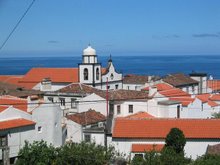Under the headline "Gaelic Jargon Lessons for Civil Servants" I read in the media of an "online toolkit" being "rolled out" to employees of Forestry Commission Scotland, Scottish Natural Heritage and the Crofters Commission in order to provide them with useful phrases in Gaelic relevant to their spheres of operation.
(For non-Scottish readers, FCS, SNH and the CC are the Scottish government agenices
responsible respectively for forestry, nature conservation and
small farms. Gaelic is a language spoken by a small minority of Scots: all Gaelic speakers also speak English.)
I was amusing myself at the thought of some earnest young FCS apparatchik (with a name like Alpin Leadbetter, a degree in Geology and Arc-welding and a fleece bearing his employer's logo) frantically booting up the toolkit in order to be able to drop the Gaelic for "sitka spruce" into conversation with some bulbous nosed crofter from Wester Ross on the scrounge for tax-payers' money to plant a community woodland with. And that, being from Manitoba, Alpin fails to spot that the crofter's lilting accent is that of Wiltshire rather than Wester Ross and consquently doesn't have a single word of "garlic" in his body. Not to mention the fact that, as there isn't an English for "sitka spruce", there's highly unlikely to be a Gaelic for it.
 |
| Roughcastle Community Wood - what's the Gaelic for "inspirational"? |
So far so titter-value until I got to a quote in the story from John Angus Mackay, chief executive of
Bord na Gaidhlig (Gaelic language agency) who praised the Gaelic jargon toolkit for "raising the profile of our own national language".
What? Gaelic, Scotland's national language?
What RUBBISH!
Quite apart from the absurdity of describing as a "national language" a tongue spoken by fewer than 2% of the nation's population, what the Gaelic cultural imperialism zealots persistently overlook is that there are vast areas of Scotland where Gaelic has NEVER been spoken, namely the green and yellow bits on the map below:-
The green bits just happen to include the country's capital (Edinburgh), biggest city (Glasgow) and the bits where two thirds of its population lives so it seems John Angus MacKay of
Bord na Gaidhlig needs a basic lesson in the linguistic history of Scotland. Here it is - this is not very difficult.
The aboriginal language of Scotland was what linguists call a "P-Celtic" language, the closest surviving example of which is modern Welsh. In the first millenium AD, Scotland was invaded by Gaels from Ireland speaking Gaelic (a "Q-Celtic" language) and Angles from England speaking - wait for it - English (a teutonic language). Gaelic spread east and south while English spread north and west. The aboriginal P-Celtic language was snuffed out between this linguitic pincer movement. The high water mark of Gaelic's spread was as coloured pink on the map. That was in the 11th century AD. Since then, it has been retreating back north and west in the face of English (green on the map) to the point where Gaelic is now spoken by only about 60,000 people - 1.2% of the population - in the very far north west and the Western Isles.
The following picture illustrates what a polyglot culture Scotland in fact has, historically speaking. It's of a road-sign near Inverness:-
Looking at all these names, Muir of Ord is English (Muir = Moor); Thurso is Norwegian reflecting the Viking heritage of north east Scotland (yellow on the map). I don't know what it means but compare with names of places in Norway like Oslo and Bodo etc. And Beauly is even French -
Beau Lieu. Yet some apparatchik with a greater sense of political correctness than of Scotland's diverse cultural make up has seen fit to translate it all into Gaelic!
Why? Judged by the numbers of speakers in Scotland, it would make as much sense to translate all these names into Punjabi or Polish!
I agree with David and I'm going to hit "Publish" now before I get any more ventilated about this.










